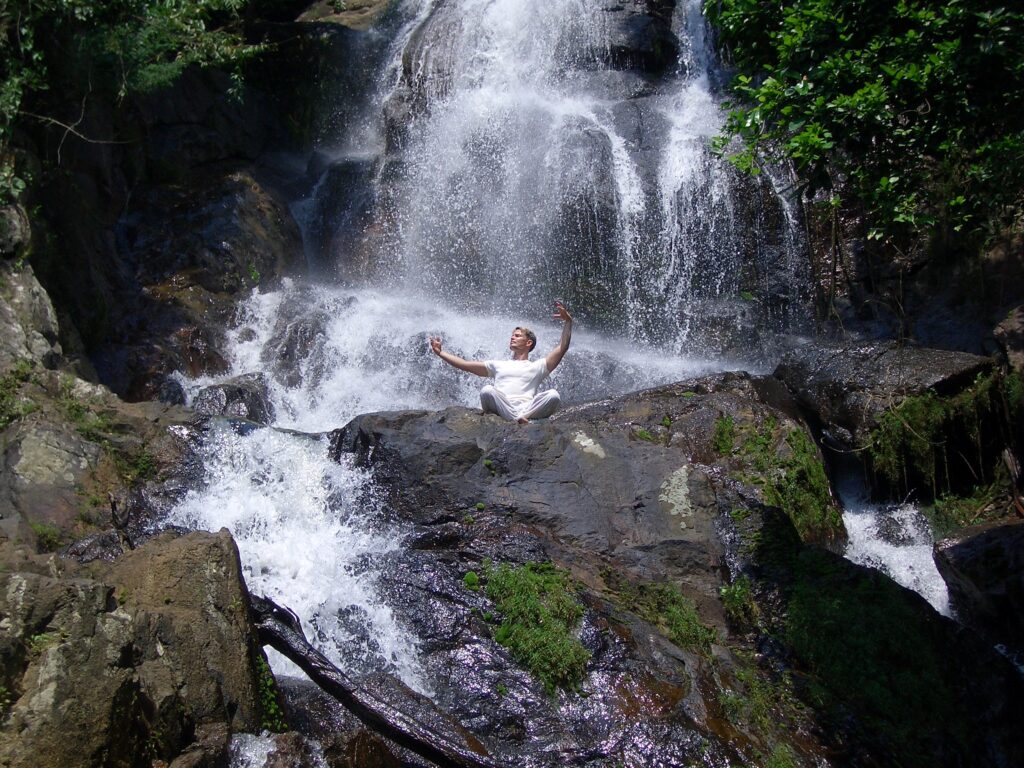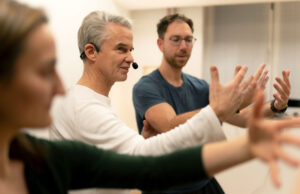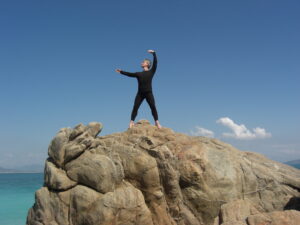
Finding the Secrets of Aliveness
An essay by Carsten Dohnke.
Finding the Secrets of Aliveness
The Three Pillars of Qigong and Western Body Therapies
The article explains the essence and the core of Qigong clearly and unambiguously and also draws comparisons to western therapy method.
Qigong, an ancient Chinese practice, is all about harnessing and nurturing your life force to foster inner and spiritual growth. This article delves into the essence of Qigong, emphasizing its three core pillars: movement, breath, and the power of the mind, including concentration and imagination. It also explores similarities and differences with Western therapeutic methods. A key takeaway is that Qigong aims to enhance vitality and process old emotions or traumas through physical exercises, mental focus, and breath control.
The Essence of Qigong
Qigong, rooted in Taoism, Buddhism, and traditional Chinese medicine, is a sophisticated practice system that promotes the flow of life energy, or Qi, within the human body. As Carsten Dohnke explains, this ancient art involves life-care practices and shares insights with Western body therapies. The Chinese tradition believes that the entire cosmos, including the human body, is infused with this vital energy. When Qi flows harmoniously and abundantly, we feel healthy, balanced, and full of vitality and inner strength. In other words, we feel truly alive and gain a fresh perspective on ourselves and the world around us.

Recognizing the Problem
Across different cultures and eras, people have noticed a common tendency: as we age, our liveliness diminishes. Unlike children, who often exhibit boundless energy, adults gradually restrict their inner vibrancy, often unconsciously. This self-limitation manifests through limited movement, chronic muscle tension, and adopting postures that reflect predominant feelings while ignoring others. Permanently tense body parts suffer from poor blood and energy flow, resulting in limited perception and mobility. For instance, someone with a chronically tense pelvis may struggle to access their sexual energy and main energy sources. Similarly, a person who habitually raises their shoulders in fear or hunches over cannot fully experience joy. This mind-body connection is vividly captured in expressions like “carrying a burden on one’s shoulders.” Whether vitality restrictions are solely due to unexpressed emotions is debated, with chronic bad posture possibly stemming from poor habits or congenital weaknesses.
Taking Action
So, what can we do to reclaim our vitality? First and foremost, we must work on gradually releasing chronic muscle tension and correcting poor posture. The goal is simple yet profound: to stand naturally and upright without effort. In this state, our energy naturally centers itself – this posture is also called “Embarcing the tree” in Qigong and taoist practices. It is the core posture of every Taiji- und Qigong-style.
Small adjustments can make a big difference, though they require time and patience. As we relax physically and mentally, hidden feelings surface and need to be processed on both physical and emotional levels. This process might trigger unexpected emotions like anger or sadness, even without an apparent cause. Physical responses such as sweating, unease, or digestive issues may also occur. These reactions are positive signs of the body’s self-regulation, striving to restore inner balance.
However, eliminating chronic tension and a bad posture is just one of Qigong’s three main pillars. This aspect aligns closely with many Western bodywork and therapy approaches.
THREE PILLARS OF QIGONG
In Qigong, however, there are two more: the strengthening and cleansing of the body and the sensitization of perception.
If you practice qigong, you spend a lot of time strengthening your whole body. Not only does this serve the purpose of not being susceptible to illness, but its primary goal is to be able to absorb a high potential of energy. As a rule, the strengthening of the body takes place through long lasting standing exercises in connection with special breathing techniques: One stands like a rock and has the feeling that roots sprout out of the feet which penetrate deeper and deeper into the ground. The breath becomes calmer and finer. Its power fills the entire lower abdomen. Why this very exercise, which is called the Standing Column in professional circles, serves to build up the entire body, is often a mystery to the layman. On the outside, almost nothing happens.

But this is precisely the secret. Strengthening begins from the inside and from below: The lower abdomen expands to all sides. The deep breath massages and cleanses the internal organs. A feeling of warmth spreads in the centre and slowly penetrates from there into the periphery. From the feet, fine energetic vibrations rise up into the legs and gradually flood the whole body. With increasing practice time, the standing person transforms into a pulsating energy field. This effect can only occur because the strengthening of the body in Qigong begins in the center and at the roots: it hits the practitioner directly in his essence.
The sensitization of perception is the third pillar of Qigong. Almost all important and well-known Qigong exercises serve mainly the sensitization, i.e. the ever finer and more differentiated perception of the body, the thoughts and the outside world. Sensitivity, however, does not only mean that the practitioner becomes more receptive to the mood of his fellow human beings and the events of his environment, because he views the world more from his center.The actual change in perception occurs on another level, the energetic level: the deeper the practitioner penetrates into the practice of qigong, the more he perceives that a fine energetic field also exists around the body. When he begins to understand this field as part of his own being, the usual boundaries of his body gradually become blurred: the energetic field develops into a sixth sense organ. It becomes a kind of spürzone, with the help of which he can directly grasp the energetic radiation of his fellow human beings and the environment – i.e. without further sensory impressions. Instead of intellectual analysis, intuition moves into the foreground of perception.
 THE HARMONY OF OPPOSITES
THE HARMONY OF OPPOSITES
The interaction between body and mind, which also takes place through strengthening and sensitization exercises, does not only happen in the area of the musculature and the skeletal apparatus. In truth, the whole body is the expression and limitation of my being, because the interplay between body and mind takes place on all possible levels. The joints, organs, connective tissue and bone marrow are just as much a part of it as the muscles, the spine posture, the tendons, the skin and everything else. By understanding this interplay, which extends to all areas, a decisive and often misunderstood point becomes particularly clear: It is not only the goal of meditative exercises to achieve a deep state of relaxation, but to experience all parts of the body in a harmonious interplay. Many people attend a meditation or Qigong course with the idea of finally coming to rest. The idea of Qigong is to achieve inner balance, harmony and a calming of the mind. But this goal is not achieved if you just relax. In short, harmony and liveliness need structure.
Tension and relaxation always come together. In Qigong, for example, it is said that Yin and Yang must always interact with each other. Real balance is only achieved when opposing aspects complement each other. This can be well understood using the example of a river: When a person practices for a long time, he becomes a great river. Huge quantities of water flow through a river. If one observes its flow, one feels a feeling of harmony and liveliness. If the riverbed or the dike is destroyed now, the current will overflow its banks. Maybe a lake will form there, but the flow and the liveliness will stop. The river does not flow without its intact riverbed.
It is the same with humans: A harmonious and living person is a vessel for feelings, sensations and excitement. The weaker and more porous the vessel, the lower the degree of inner arousal.
Explained using the example of correct posture, this means that it is only possible to walk upright if I stretch certain parts of the muscles. The body does not stand by itself. This basic tension gives me the possibility of inner excitement. If I reduce it beyond a certain level, it leads to the loss of my vitality. It’s that simple.

THOUGHTS, BREATH, MOVEMENT
If I want to start practicing now, I should use three tools. I need the power of my thoughts, the ability to regulate my breath and the ability to move. All Qigong exercises are made up of the skilful combination of these three aids. For a better understanding they are divided into basic exercises and higher exercises:
Typical basic exercises of today’s Qigong are gymnastics-like stretching exercises, self-massage, special breathing techniques, visualizations, grounding exercises, straight posture exercises, slow animal movements, simple meditation practices, Taiji movements and healing sounds. Many of these practices often seem somewhat mysterious to the layman. In reality, however, in many ways they resemble the health practices, relaxation methods and forms of therapy that are widespread in the West today. These include many body-oriented psychotherapies, classical healing massage, autogenic training, biodynamic massage, Feldenkrais training, positive thinking, aura work and much more.
The similarity of the different methods with the basic exercises of Qigong is that both approaches have the goal of restoring or maintaining health and vitality: They give the individual the opportunity to heal his illness and to free himself from his inhibitions and rigid behavioural structures, so that he can become a happy and active being. This being has the possibility to express his feelings, to pursue his desires and goals and to enjoy the pleasures of the senses.
Higher levels of Qigong go far beyond the approach and the idea of the physical and emotional recovery of the human being. Although they are often taught, they can only be mastered after many years of serious practice.
On these levels one learns techniques for the mental transformation of negative feelings, the transformation of sexual energy into consciousness, healing through the transmission of Qi and deep inner immersion. Such techniques are not taught in traditional Western approaches of bodywork.
MEDITATIVE EXERCISES
Clear parallels can be found in comparison with the various yoga systems, Buddhism and Zen Buddhism, the Tantra systems and Christian mysticism. The meditative exercises of all these spiritual traditions, as well as the higher levels of Qigong, cannot be practiced without their spiritual background. They are embedded in the understanding of basic ethical attitudes and only through this unfold their full effectiveness. Because the actual goal of these exercises is not the private happiness of the individual human being, but the connection of the human being with the cosmos.
This requires the inner readiness of the individual to put his self, with all his desires, feelings and views about the world, in the background and to direct his senses completely inwards.
WHAT IS QI?
One of the biggest misunderstandings in the field of Qigong and meditation has arisen through the term Qi. In China and also among the qigong practitioners of the West one speaks constantly of Qi. For many people, however, the word “qi” conceals the great unknown. Some voices therefore ask for a concrete definition of the term or think they have already found it.
Even though such a definition is very important and is likely to clarify many misunderstandings, one thing should not be forgotten: Qi is just a name. A name for something you can experience for yourself. And somehow it has to do with liveliness. That’s why I like to ask back: “What is life?


